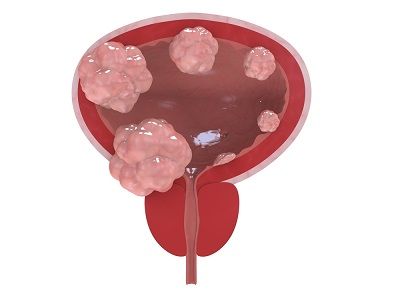UGN-103 Exhibits Durable Responses in Recurrent LG-IR-NMIBC
The FDA agreed that data from the UTOPIA trial, with UGN-103 demonstrating a 77.8% 3-month CR rate in patients with LG-IR-NMIBC, support an NDA submission.
According to the developers, this finding was consistent with a different formulation of mitomycin (Zusduri), which attained a 3-month CR rate of 79.6% in the phase 3 ENVISION trial.

UGN-103 (mitomycin) exhibited durable responses as an intravesical agent for patients with recurrent low-grade, intermediate-risk non–muscle-invasive bladder cancer (LG-IR-NMIBC), according to a news release from the drug’s developer, UroGen Pharma.1
Top-line efficacy data from the phase 3 UTOPIA trial (NCT06331299), which assessed the investigational agent at 75 mg once weekly for up to 6 weeks, revealed that the 3-month complete response (CR) rate was 77.8% (95% CI, 68.3%-85.5%). According to the developers, this finding was consistent with a different formulation of mitomycin (Zusduri), which attained a 3-month CR rate of 79.6% (95% CI, 73.9%-84.5%) in the phase 3 ENVISION trial (NCT05243550).
Additionally, the FDA has agreed that the UTOPIA trial results support the submission of a new drug application (NDA) submission, citing the CR and durability results of the select formulation in patients with recurrent LG-IR-NMIBC.
“The robust 77.8% 3-month CR rate observed in the UTOPIA trial is highly encouraging and reinforces the potential of UGN-103 to deliver meaningful benefits to patients,” Liz Barrett, president and CEO of UroGen, stated in the news release.1 “In addition, the FDA’s agreement that the UTOPIA trial can support the submission of an NDA for UGN-103 represents a significant regulatory milestone and a strong validation of our clinical strategy…. We look forward to working closely with the FDA as we complete the UTOPIA trial and prepare for an NDA submission in 2026.”
The phase 3 UTOPIA trial was a single-arm trial evaluating the safety and efficacy of UGN-103 globally. UGN-103 consisted of mitomycin and a sterile hydrogel, which was developed to reconstitute mitomycin before instillation.2 Observation of response was based on observation with white light cystoscopy and histopathology of remaining lesions and interpretation of urine cytology, both by central pathology laboratory.
Those who experienced no detectable disease at the 3-month visit entered the study follow-up period. Patients therein returned for follow-up every 3 months, with follow-up persisting in the absence of disease progression or recurrence, death, or until the last patient completes 12 months of follow-up. Those without a CR at the 3-month follow-up underwent investigator-assigned standard-of-care treatment and were given a separate end-of-study visit.
The primary end point of the trial was CR rate. Secondary end points included duration of response, durable CR rate, safety, and pharmacokinetics.
According to the developers, UGN-103 was designed with key improvements over the Zusduri formulation, including a shorter manufacturing process and simplified reconstitution procedure. The Zusduri formulation is delivered via a urinary catheter in an outpatient setting as a nonsurgical treatment for bladder tumors.
Eligibility criteria for the phase 3 UTOPIA trial included histological confirmation of LG-NMIBC via cold cup biopsy at screening or within 8 weeks of screening; 1 prior NMIBC episode; and intermediate-risk disease, defined as having no more than 2 criteria of the following: multiple tumors; a solitary tumor greater than 3 cm in size; and early or frequent recurrence, defined as at least 1 event within 1 year of current diagnosis. Patients must also have had negative void cytology results for high-grade disease within 8 weeks of screening, adequate organ and bone marrow function, and a life expectancy of the duration of the trial at a minimum.
Those ineligible for trial enrollment included those with BCG treatment for urothelial carcinoma within 1 year of study treatment, a history of high-grade bladder cancer within 2 years of study treatment, and clinically significant urethral stricture affecting urethral catheter use. Additionally, a history of neurogenic bladder, active urinary retention, conditions prohibiting normal voiding, past or current MIBC or metastatic urothelial cancer, or evidence of active urinary tract infection unable to be treated or resolved prior to biopsy or study treatment per investigator assessment were excluded from trial enrollment.
References
- UroGen reports 77.8% three-month complete response rate from phase 3 UTOPIA trial of UGN-103 and receives FDA agreement on NDA submission strategy in recurrent LG-IR-NMIBC based on UTOPIA trial. News release. UroGen Pharma. November 6, 2025. Accessed November 6, 2025. https://tinyurl.com/4jzzpwxm
- A phase 3 study of UGN-103 for treatment of patients with low-grade intermediate-risk non-muscle invasive bladder cancer (UTOPIA). ClinicalTrials.gov. Updated April 9, 2025. Accessed November 6, 2025. https://tinyurl.com/y3azb2rd